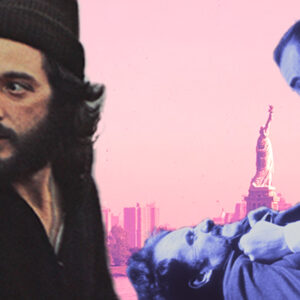Is Robert Altman’s The Long Goodbye the most overrated crime film of 1973? For that matter, is it one of the most overrated crime films of the 1970s?
When I recently posed this question on social media, it was interesting to see how polarised views are. For many, The Long Goodbye remains one of the most memorable and distinguished films of the 1970s, fully deserving of the canonisation its reappraisal over roughly the last decade has brought, including a 2021 decision by the American Library of Congress to include it in its National Film Registry. For others, it is not only a terrible take on Raymond Chandler’s iconic gumshoe character, Philip Marlowe, but a completely over-hyped piece of crime cinema.
The Long Goodbye’s follows the standard private investigator plot (and warning, spoilers ahead). Business is slow for Marlowe (Elliot Gould) and his life appears to be in a state of barely controlled chaos. Following an extended and wonderfully executed opening sequence in which the shambolic Marlowe has hunted down a particular brand of food for his fussy cat at 3am, he is visited by an old friend, Terry Lennox (Jim Bouton). Terry needs a lift from Los Angeles to the Mexican border town of Tijuana. Marlowe obliges, only learning on his return that the police believe Lennox has murdered his wife, Sylvia. After a brief stint in jail, Marlowe learns that Lennox has committed suicide in Mexico. It is actually pretty clearly signposted when we first see Lennox that he has been involved in something very bad. But Marlowe doesn’t know this, and in any case, Lennox is his friend, so he is suspicious about the claim he killed his wife and about his apparent suicide.
Then Marlowe gets a case, the apparent simplicity of which is completely inverse to just how complex and dangerous the situation really is. Eileen Wade (Nina van Pallandt) hires him to find her husband. Roger Wade (Sterling Hayden) is an abusive alcoholic novelist with writer’s block prone to disappearing. Marlowe locates him in a detox clinic for the rich and returns him to his wife at their stunning beachside bungalow in Malibu (Altman’s house in real life). In the process, Marlowe discovers the Wades knew Terry and Sylvia Lennox socially. Roger Wade eventually commits suicide and, supposedly in her grief, his wife tells Marlowe her husband was having an affair with Sylvia and might have been responsible for her death. Parallel with these events, Marlowe is visited by a vicious gangster Marty Augustine (Mark Rydell), who was owed money by Lennox and holds Marlowe responsible for the debt. Next Eileen disappears. Marlowe goes to Mexico where he discovers that Lennox bribed the police to say he had killed himself. Marlowe locates Lennox in a remote villa where he is living large on Augustine’s money and having an affair with Eileen. He boasts to Marlowe that he indeed killed his wife and gloats that most of what the PI has been doing has been one giant misdirection away from Lennox’s guilt, that Marlowe has been a complete sucker, and that no cares anyway. In response Marlowe shoots him dead. The final scene, reminiscent of the end of Carol Reed’s 1949 film noir, The Third Man, sees Marlowe walking down a road, straight past Eileen, who is driving her jeep towards Lennox’s, without acknowledging her.
The Long Goodbye was pitched to other directors, including Howard Hawks and Peter Bogdanovich, before landing with Altman. The screenplay was written by Leigh Brackett, probably best remembered now for her science fiction, but who had history with the material: she had helped write the screenplay for the 1946 Marlowe vehicle of The Big Sleep, starring Humphrey Bogart. Gould almost didn’t get the part because he’d been difficult on the set of his previous film, the 1971 romantic comedy, A Glimpse of the Tiger, and United Artists made him take a psychological examination attesting to his stability, to get the role. Brackett’s script is not particularly faithful to the source material, Chandler’s 1953 novel of the same name, which Altman subsequently confessed he hadn’t read all of anyway. The decision to place Marlowe smack bang in the counterculture infused ethos of narcissism and self-actualisation of early 1970s Los Angeles, disoriented audiences and critics, the latter of whom panned it. The film’s chances weren’t helped by the United Artists marketing department, who initially promoted the film as a conventional detective story, which it wasn’t. Then they overhauled the campaign, including a new a poster by Mad magazine artist Jack Davis, to play it up as a comedy, which it wasn’t either.
The film has some beautiful camera work by veteran Hollywood cinematographer Vilmos Zsigmund, and the innovative multi-layered use of sound that would become a key component of Altman’s style. There are great performances: Gould is wonderful – then again, he is great in everything he touches – also Pallandt and Rydell, the latter stealing every scene he is in as a sort of hep-cat psychopath. But much of The Long Goodbye’s dialogue and some of the character interactions feel scrappy, no doubt because parts were ad libbed. These include some of the scenes between Marlowe and Wade because Hayden was too stoned and drunk most of the time to remember his lines. As a side note, it is disturbing to watch Hayden in The Long Goodbye and see how he seemingly fell to pieces in the short time since he’d delivered a small but powerful role as the corrupt cop McCluskey in 1972’s The Godfather. Plotwise, The Long Goodbye is also a bit of a mess. The last few minutes, in which Marlowe pivots from a lackadaisical participant observer of life to a cold blooded murderer, make no sense in terms of the character arc. And the core narrative thread of the film feels padded out and is confused by the addition of various non sequitur encounters and characters that come from and go nowhere. This is something it shares with other private investigator films that emerged from ‘New Hollywood’ in the first half of the 1970s. On a recent rewatch of Roman Polanksi’s Chinatown, my first for about ten years, I was struck by just how little sense large parts of the film, released in 1974, made (I still love it). Arthur Penn’s Nightmoves occupies the same territory. Whatever the case, one can’t deny The Long Goodbye’s undoubted influence, informing successive slacker takes on the private investigator, such as The Big Lebowski (1998) and Inherent Vice (2014).
For many, whether they like The Long Goodbye seems to depend on how much of a Chandler traditionalist they are. Personally, I have never been a great fan of his books, preferring the work of Dashiell Hammett. The point is Altman and Brackett never claimed to be faithful to the source material. Regardless, Gould’s Marlowe retains the core characteristics of the Chandler’s Marlowe, the private investigator committed to exploring the seedy underbelly of Los Angeles and its criminal rich. It would be an interesting exercise to see how this iteration of Marlowe stacks up with the other big screen adaptations of Chandler’s work. In addition to The Big Sleep, these include: Dick Powell in Murder My Sweet (1944), Robert Montgomery in Lady in the Lake (1947), James Garner in the little known but from memory very good Marlowe (1969), Robert Mitchum in Farewell My Lovely (1975) – my favourite – and Mitchum again in a terrible British set version of The Big Sleep (1978), and the latest outing, Marlowe (2023), with Liam Neeson.
I like my noir darker and far less overtly and painfully self-conscious of its history and baggage than The Long Goodbye, and without the thickly layered meta narrative. Just staying with 1973, for me the film is no better and is, indeed, arguably worse than the other lauded crime films released that year: Mean Streets, Badlands, Serpico, and The Friends of Eddie Coyle. Not to mention the films from 1973 that are known among crime cinema aficionados but lack the wider cultural purchase delivered by auteur an helmed effort: James William Guerico’s Electra Glide in Blue; John Flynn’s The Outfit; Raymond St Jacques’s Book of Numbers, based on the book by the little known Black author, Robert Deane Pharr; Don Siegel’s Charley Varrick; Stuart Rosenberg’s The Laughing Policeman; Jack Hill’s Coffy; and Arthur Marks’s gritty heist film Detroit 9000.
Of course, this is all irrelevant if you don’t view The Long Goodbye within strict genre terms, and maybe not even as a crime film at all. Altman was an idiosyncratic director with a habit of completely subverting genres. In the 1970s, alone, he did this with his anti-western McCabe & Mrs. Miller (1971), his take on the low life crime film, California Split (1974), and his wonderfully bizarre American giallo 3 Women (1977). In The Long Goodbye he deconstructed the classic private investigator tale, deliberately unmooring film noir tropes from their historical setting, an idea that was much more radical in 1973.
But I suspect the real reason the film is so prized now is how it acts as a time machine. When a down on his luck gumshoe could afford a cool apartment in Hollywood Heights and a past his prime unproductive writer could live by the sea in Malibu. Where the gate guards did impersonations of classic Hollywood actors. A place of wood panelled dive bars, 27/4 partying hippie women (I guess Manson didn’t completely kill the party after all), and carefree spur of the moment trips to Mexico. And so many other cultural and historical markers, large and small, that are long gone and never to return. A Los Angeles virtually all of us never experienced and may not even have really existed at all.

















